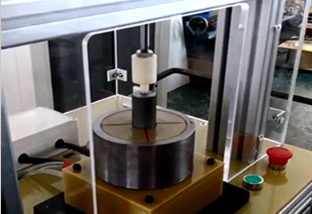What are the common sensor failures and their solutions for brushless motor motor automatic rotor magnetizer?
The common sensor failures and solutions for brushless motor motor automatic rotor magnetizer are as follows:
1、Position sensor failure
l Failure phenomenon
The rotor magnetizing position is inaccurate, resulting in poor magnetizing effect and affected motor performance. For example, the magnetic pole position is offset, which makes the motor torque output unstable.
The magnetizer is unable to recognize the initial position of the rotor correctly, which may cause the magnetization process to fail to start normally.
l Cause of Failure
The mounting position of the position sensor is shifted so that the rotor position it detects does not match the actual position.
The sensor itself is damaged, such as aging, short-circuiting or disconnection of internal components, and cannot output the position signal normally.
Problems in the signal transmission line of the sensor, such as broken lines, poor contact, resulting in signal loss or distortion.
l Solution
Re-calibrate the installation position of the position sensor to ensure that it accurately detects the rotor position. Professional calibration tools and methods can be used, following the installation manual of the device.
Test the sensor, and if it is determined that the sensor is damaged, replace the sensor with the same model in time.
Check the signal transmission line, repair the broken line, reconnect the loose connector to ensure stable signal transmission.
2、Temperature sensor failure
l Failure phenomenon
The temperature value displayed by the magnetizer is inaccurate, and there may be false alarms that the temperature is too high or too low, affecting the normal operation of the equipment and maintenance decisions.
When the actual temperature of the magnetizer is too high, the temperature sensor fails to send out an alarm signal in time, which may lead to damage of the equipment due to overheating.
l Cause of Failure
The temperature sensor is interfered by external environmental factors, such as electromagnetic interference, high temperature radiation, etc., affecting its measurement accuracy.
The measuring probe of the sensor is damaged, such as dirt, oxidation or physical damage on the probe surface, resulting in failure to accurately sense the temperature.
The calibration of the temperature sensor is inaccurate, with the use of time, the sensor's measurement value may be deviated.
l Solution
Add shielding to the temperature sensor to reduce the influence of external electromagnetic interference; avoid the sensor being close to high-temperature radiation sources.
Clean or replace the measuring probe of the temperature sensor to ensure that its surface is clean and undamaged.
Regularly calibrate the temperature sensor, use a standard temperature source for comparative measurements, adjust the output value of the sensor, so that it measures accurately.

3、Current sensor failure
l Failure phenomenon
The magnetizing current display is abnormal and does not match the actual magnetizing current value, which may lead to unstable magnetizing strength and affect the magnetizing quality of the rotor.
When the magnetizing current is too large, the current sensor fails to detect and trigger the protection mechanism in time, which may damage the magnetizing coil or other electrical components.
l Failure Causes
The range of the current sensor is not properly selected, and it cannot accurately measure the current change during the magnetizing process.
The Hall element or other detection components inside the sensor are damaged, resulting in inaccurate current measurement.
The installation position of the current sensor is not reasonable, affected by the surrounding magnetic field or electric field, resulting in measurement error.
l Solution
According to the actual working current range of the magnetizer, select the current sensor with suitable range.
Test and repair the current sensor, and replace it in time if the key components such as Hall element are damaged.
Adjust the installation position of the current sensor to avoid its interference by external magnetic and electric fields to ensure the accuracy of measurement.
4. Pressure sensor failure (if any)
l Failure phenomenon
When the magnetizer needs to apply certain pressure to the rotor during the magnetization process, the pressure value displayed by the pressure sensor is inaccurate, which may lead to damage to the rotor if the pressure is too large, or the pressure is too small to achieve a good magnetization effect.
The pressure sensor is unable to detect the pressure change, so the magnetizer cannot adjust and protect accordingly to the pressure condition.
l Cause of Failure
The diaphragm of the pressure sensor is damaged, resulting in inability to accurately sense pressure changes.
Failure of the internal circuit of the sensor, such as damage to the amplifier, failure of the signal processing chip, etc., affecting the output of the pressure signal.
The installation of the pressure sensor is not sealed properly, resulting in pressure leakage and inaccurate measurement value.
l Solution
Replace the diaphragm of the pressure sensor to ensure that it can sense pressure normally.
Test and repair the internal circuit of the sensor and replace the damaged components.
Reinstall the pressure sensor to ensure that the installation is well sealed to avoid pressure leakage.
※ If the above ways and means still can not solve the equipment failure, please contact the technical specialist of Xinhui Electromechanical Equipment Co.







